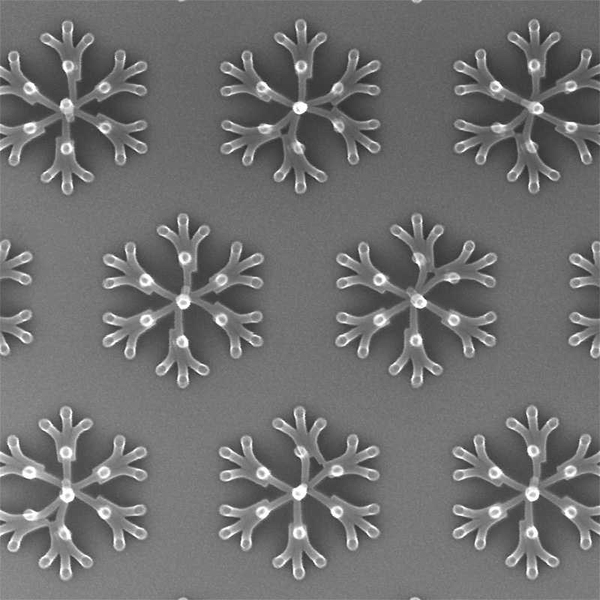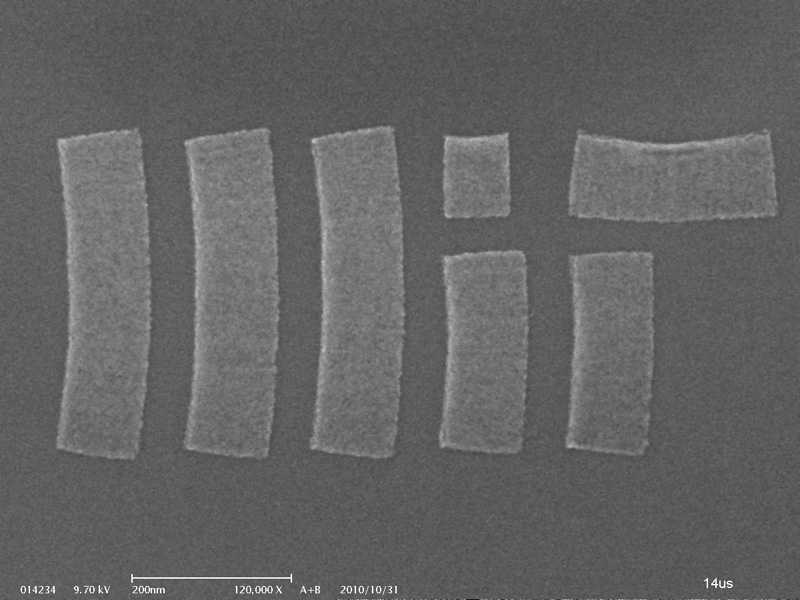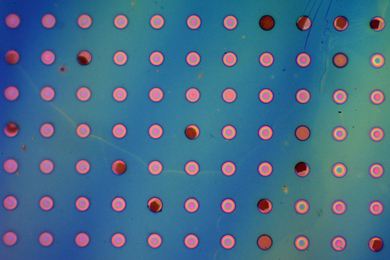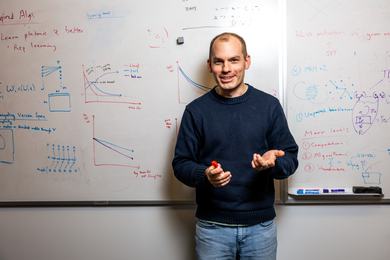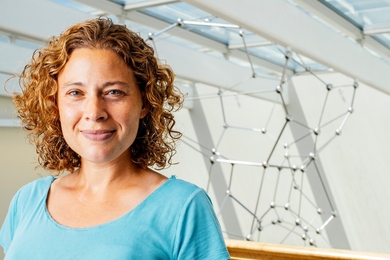The manufacture of nanoscale devices — the transistors in computer chips, the optics in communications chips, the mechanical systems in biosensors and in microfluidic and micromirror chips — still depends overwhelmingly on a technique known as photolithography. But ultimately, the size of the devices that photolithography can produce is limited by the very wavelength of light. As nanodevices get smaller, they’ll demand new fabrication methods.
In a pair of recent papers, researchers at MIT’s Research Laboratory of Electronics and Singapore’s Engineering Agency for Science, Technology and Research (A*STAR) have demonstrated a new technique that could produce chip features only 10 nanometers — or about 30 atoms — across. The researchers use existing methods to deposit narrow pillars of plastic on a chip’s surface; then they cause the pillars to collapse in predetermined directions, covering the chip with intricate patterns.
Ironically, the work was an offshoot of research attempting to prevent the collapse of nanopillars. “Collapse of structures is one of the major problems that lithography down at the 10-nanometer level will face,” says Karl Berggren, the Emanuel E. Landsman (1958) Associate Professor of Electrical Engineering and Computer Science, who led the new work. “Structurally, these things are not as rigid at that length scale. It’s more like trying to get a hair to stand up. It just wants to flop over.” Berggren and his colleagues were puzzling over the problem when, he says, it occurred to them that “if we can’t end up beating it, maybe we can use it.”
Status quo
With photolithography, chips are built up in layers, and after each layer is deposited, it’s covered with a light-sensitive material called a resist. Light shining through an intricately patterned stencil — called a mask — exposes parts of the resist but not others, much the way light shining through a photographic negative exposes photo paper. The exposed parts of the resist harden, and the rest is removed. The part of the chip unprotected by the resist is then etched away, usually by an acid or plasma; the remaining resist is removed; and the whole process is repeated.
The size of the features etched into the chip is constrained, however, by the wavelength of light used, and chipmakers are already butting up against the limits of visible light. One possible alternative is using narrowly focused beams of electrons — or e-beams — to expose the resist. But e-beams don’t expose the entire chip at once, the way light does; instead, they have to scan across the surface of the chip a row at a time. That makes e-beam lithography much less efficient than photolithography.
Etching a pillar into the resist, on the other hand, requires focusing an e-beam on only a single spot. Scattering sparse pillars across the chip and allowing them to collapse into more complex patterns could thus increase the efficiency of e-beam lithography.
The layer of resist deposited in e-beam lithography is so thin that, after the unexposed resist has been washed away, the fluid that naturally remains behind is enough to submerge the pillars. As the fluid evaporates and the pillars emerge, the surface tension of the fluid remaining between the pillars causes them to collapse.
Getting uneven
In the first of the two papers, published last year in the journal Nano Letters, Berggren and Huigao Duan, a visiting student from Lanzhou University in China, showed that when two pillars are very close to each other, they will collapse toward each other. In a follow-up paper, appearing in the Sept. 5 issue of the nanotech journal Small, Berggren, Duan (now at A*STAR) and Joel Yang (who did his PhD work with Berggren, also joining A*STAR after graduating in 2009) show that by controlling the shape of isolated pillars, they can get them to collapse in whatever direction they choose.
More particularly, slightly flattening one side of the pillar will cause it to collapse in the opposite direction. The researchers have no idea why, Berggren says: When they hatched the idea of asymmetric pillars, they expected them to collapse toward the flat side, the way a tree tends to collapse in the direction of the axe that’s striking it. In experiments, the partially flattened pillars would collapse in the intended direction with about 98 percent reliability. “That’s not acceptable from an industrial perspective,” Berggren says, “but it’s certainly fine as a starting point in an engineering demonstration.”
At the moment, the technique does have its limitations. Space the pillars too close together, and they’ll collapse toward each other, no matter their shape. That restricts the range of patterns that the technique can produce on chips with structures packed tightly together, as they are on computer chips.
But according to Joanna Aizenberg, the Amy Smith Berylson Professor of Materials Science at Harvard University, the applications where the technique will prove most useful may not have been imagined yet. “It can open the way to create structures that were just not possible before,” Aizenberg says. “They’re not in manufacturing yet because nobody knew how to make them.”
Although Berggren and his colleagues didn’t know it when they began their own experiments, for several years Aizenberg’s group has been using the controlled collapse of structures on the micrometer scale to produce materials with novel optical properties. But “particularly interesting applications would come from this sub-100-nanometer scale,” Aizenberg says. “It’s a really amazing level of control of the nanostructure assembly that Karl’s group has achieved.”
In a pair of recent papers, researchers at MIT’s Research Laboratory of Electronics and Singapore’s Engineering Agency for Science, Technology and Research (A*STAR) have demonstrated a new technique that could produce chip features only 10 nanometers — or about 30 atoms — across. The researchers use existing methods to deposit narrow pillars of plastic on a chip’s surface; then they cause the pillars to collapse in predetermined directions, covering the chip with intricate patterns.
Ironically, the work was an offshoot of research attempting to prevent the collapse of nanopillars. “Collapse of structures is one of the major problems that lithography down at the 10-nanometer level will face,” says Karl Berggren, the Emanuel E. Landsman (1958) Associate Professor of Electrical Engineering and Computer Science, who led the new work. “Structurally, these things are not as rigid at that length scale. It’s more like trying to get a hair to stand up. It just wants to flop over.” Berggren and his colleagues were puzzling over the problem when, he says, it occurred to them that “if we can’t end up beating it, maybe we can use it.”
Status quo
With photolithography, chips are built up in layers, and after each layer is deposited, it’s covered with a light-sensitive material called a resist. Light shining through an intricately patterned stencil — called a mask — exposes parts of the resist but not others, much the way light shining through a photographic negative exposes photo paper. The exposed parts of the resist harden, and the rest is removed. The part of the chip unprotected by the resist is then etched away, usually by an acid or plasma; the remaining resist is removed; and the whole process is repeated.
The size of the features etched into the chip is constrained, however, by the wavelength of light used, and chipmakers are already butting up against the limits of visible light. One possible alternative is using narrowly focused beams of electrons — or e-beams — to expose the resist. But e-beams don’t expose the entire chip at once, the way light does; instead, they have to scan across the surface of the chip a row at a time. That makes e-beam lithography much less efficient than photolithography.
Etching a pillar into the resist, on the other hand, requires focusing an e-beam on only a single spot. Scattering sparse pillars across the chip and allowing them to collapse into more complex patterns could thus increase the efficiency of e-beam lithography.
The layer of resist deposited in e-beam lithography is so thin that, after the unexposed resist has been washed away, the fluid that naturally remains behind is enough to submerge the pillars. As the fluid evaporates and the pillars emerge, the surface tension of the fluid remaining between the pillars causes them to collapse.
Getting uneven
In the first of the two papers, published last year in the journal Nano Letters, Berggren and Huigao Duan, a visiting student from Lanzhou University in China, showed that when two pillars are very close to each other, they will collapse toward each other. In a follow-up paper, appearing in the Sept. 5 issue of the nanotech journal Small, Berggren, Duan (now at A*STAR) and Joel Yang (who did his PhD work with Berggren, also joining A*STAR after graduating in 2009) show that by controlling the shape of isolated pillars, they can get them to collapse in whatever direction they choose.
More particularly, slightly flattening one side of the pillar will cause it to collapse in the opposite direction. The researchers have no idea why, Berggren says: When they hatched the idea of asymmetric pillars, they expected them to collapse toward the flat side, the way a tree tends to collapse in the direction of the axe that’s striking it. In experiments, the partially flattened pillars would collapse in the intended direction with about 98 percent reliability. “That’s not acceptable from an industrial perspective,” Berggren says, “but it’s certainly fine as a starting point in an engineering demonstration.”
At the moment, the technique does have its limitations. Space the pillars too close together, and they’ll collapse toward each other, no matter their shape. That restricts the range of patterns that the technique can produce on chips with structures packed tightly together, as they are on computer chips.
But according to Joanna Aizenberg, the Amy Smith Berylson Professor of Materials Science at Harvard University, the applications where the technique will prove most useful may not have been imagined yet. “It can open the way to create structures that were just not possible before,” Aizenberg says. “They’re not in manufacturing yet because nobody knew how to make them.”
Although Berggren and his colleagues didn’t know it when they began their own experiments, for several years Aizenberg’s group has been using the controlled collapse of structures on the micrometer scale to produce materials with novel optical properties. But “particularly interesting applications would come from this sub-100-nanometer scale,” Aizenberg says. “It’s a really amazing level of control of the nanostructure assembly that Karl’s group has achieved.”
